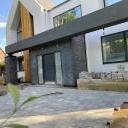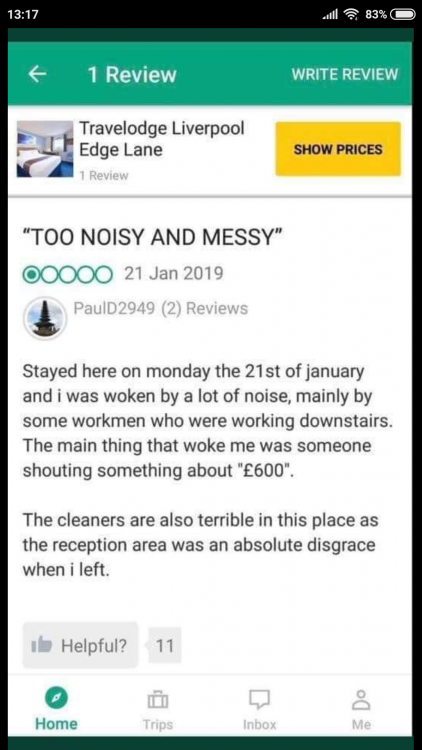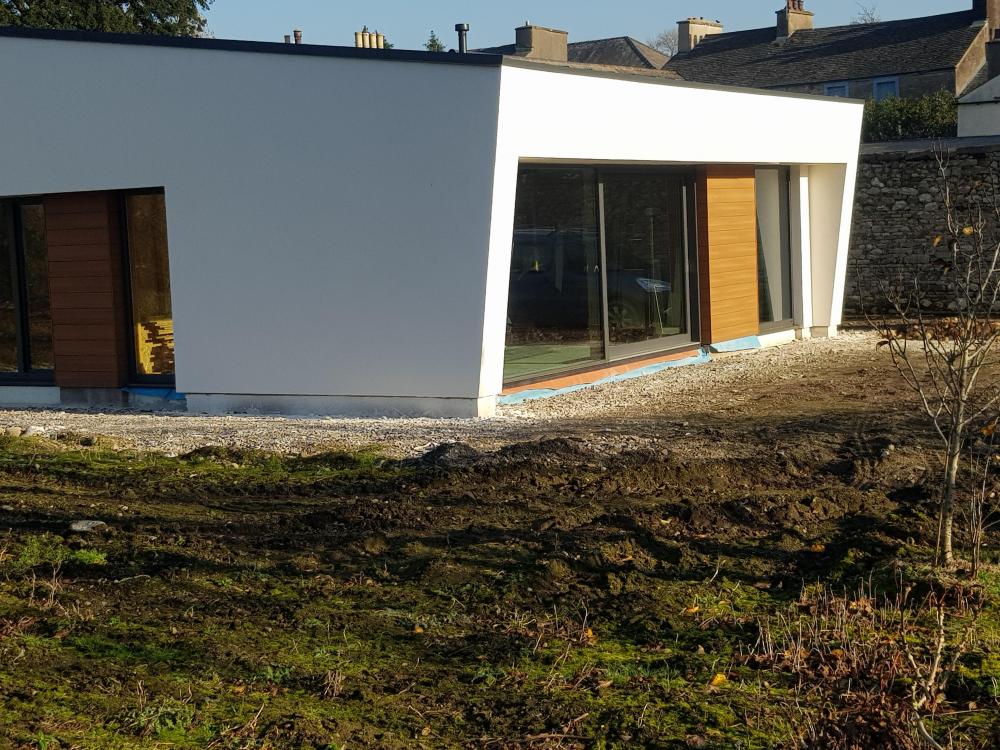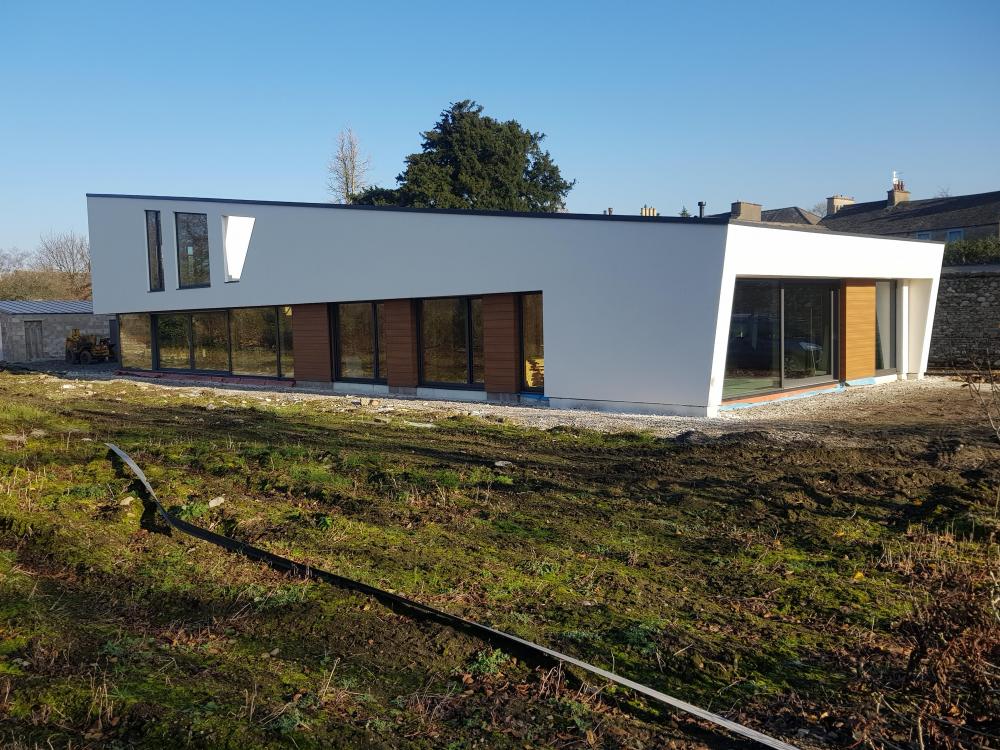Leaderboard
Popular Content
Showing content with the highest reputation on 01/23/19 in all areas
-
2 points
-
1 point
-
1 point
-
1 point
-
We considered composite cladding for our dormers and had it priced up but it’s very expensive, the quote we got was as much as it costs for 36 sq m of composite decking and that was only around 8 sq m for the 4 dormers, it did look like it would have been nice but not at the price!1 point
-
I used Osmo on our oak doors, frames, architrave, skirtings and stairs and we're happy with it. I brushed it on, and found that it was quite hard work brushing out the first coat into every nook and cranny, and easy to miss a bit. Once the first coat had hardened I de-nibbed it with a green Scotchbrite pad and applied the next coat, which went on a great deal more easily. We opted to use the satin finish, and it seems reasonably even and is wearing very well on the stairs.1 point
-
I don't think we can / will hide the downpipes (unfortunately). The walls are timber frame and MBC have designed the roof detail (posi joist roof) to accommodate the box gutter on the pitched roof with concrete slate-effect roof tiles. I have found a fabricator who will make and install the gutter so fingers crossed!1 point
-
For the £20, use the Mapei primer and do it right - you can dilute it 50/50 anyway.1 point
-
I had the dust problem so I gave the bathroom floor a coat of SBR diluted down. Lasted me well until I was ready to tile the floor. I chose SBR over PVA as I've read any water getting under tiles later on can lift PVA. I know you can get waterproof PVA but SBR is a darn sight cheaper. Cementone was the brand I used from S'fix I think it was.1 point
-
1 point
-
1 point
-
1 point
-
I can't see what the IBC adds, TBH. Might as well dig a big hole, line it with terram and fill it up with rocks.1 point
-
Our ASHP hoses run in a loop, rather than straight, as apparently that allows the vibration to be decoupled better. I think one issue is that the vibration isn't damped well along the axis of a flexible hose, hence the instructions to arrange them in a long loop.1 point
-
My pump noise was more of a whine. I changed the upstairs one first as I already had a spare Wilo pump, that was in the en-suite so proved very annoying. I have ordered a second Wilo pump to replace the downstairs pump. If any deaf member want's a couple of cheap circulating pumps let me know.1 point
-
We have four AAVs and they are just above basin overflow level and are behind false walls in the bathrooms. We have been using them for nearly a year and, "touch wood", they seem to be fine.1 point
-
I think the term 'flood level' in relation to AAVs refers to the basin overflow level.1 point
-
No, the flood level that the EA have declared for the area, the 1:100 year flood risk level. Our AAV is above the level of the top of any basin.1 point
-
We just have an AAV in the eaves space, so up high in the house, not lower down, but it's not presented any problems so far. I've no idea what the reliability of a low level, flood-resistant one might be I'm afraid. The vent in our foul drain is at the treatment plant, which is also above the flood level by about a metre.1 point
-
Do not know if this is useful but thought I would post for anyone thinking about doing a self build. Here is a break down of my fee's I have to pay before I start building. My help someone trying to estimate their costs. This is for a 4 bedroom house 280 m2 detached house The legal work was complex Fee Payable To Payable When Amount Local Authority Planning Fee East Ayshire Council Planning Submission £500.00 Architectual Plans ATW Planning Submission £2,375.00 Building Control Drawings ATW Building Warrant submitted £2,375.00 Egineering drawings ???? Building Warrant submitted £1,100.00 Building warrant East Ayshire Council Building Warrant submitted £2,228.40 Additional Security Fee BuildLoan At the start of the loan - non-refundable £1,120.00 Build Store Arrangement Fee BuildLoan Applied for mortgage - non-refundable £695.00 Completion Fee Newcastle Building Society Fee has been paid - non-refundable £995.00 Product Reservation Fee Newcastle Building Society Fee has been paid - non-refundable £199.00 Valuation Fee Newcastle Building Society Fee has been paid - non-refundable £340.00 Mortgage Discharge Fee Newcastle Building Society At the end of the Loan - non-refundable £125.00 Solicitors Fee Wallace Quinn At end of conveyancing £2,116.00 Structual Warranty Build Zone Through Out the build £3,940.00 Site Insurance Before Completion £342.12 Thanks1 point
-
@Onoff you seem to want to complicate this grouting job........ unlike you to do that1 point
-
1 point
-
I used Floplast AAVs which are "permitted to be used below flood level in locations where the temperature is in the range of -20°C to +60°C". I used them only very slightly higher than flood level but I don't see why they shouldn't be used below flood level as they are designed for that purpose. I think I would be cautious and check with some experimentation before final fitting though.1 point
-
1 point
-
Sorry, I don't know anything about these, so I think the best bet is to talk to your BCO and get an opinion, which is what I did when planning the ventilation for our foul drains.1 point
-
It's vital that the current sensor (CT) is on the supply on the grid supply side of the whole property electricity supply. This means that it's fine to have the CT on the meter tails, no matter what the installation, but only OK to have the sensor on the consumer unit tails when there is no outlet or PV inverter connection between the CT and the incoming supply at the meter. Our case illustrates this. We have our incoming supply and meter in a box mounted in a fence. The supply from there feeds the house and the main consumer unit, via a length of 25mm² SWA. The PV inverter is connected to this main CU. The supply from the meter also feeds a small CU outside that supplies power to the garage, the car charge point, the treatment plant and our water supply pump. If I was to fit the CT in the house, on the consumer unit tails, then we could be importing power from the grid when the diverter thinks we are exporting, as it won't be sensing the loads from outside the house, some of which could be high (the car charger draws up to 7 kW, for example). With the CT fitted at the meter tails, it correctly reads the whole house import/export and will only divert if we are exporting.1 point
-
Yes, I can’t see why ripping the roof off or getting a specialist company to remove asbestos is able to be zero rated yet terminating a services supply as part of a demolition cannot be.1 point
-
Perhaps someone should argue that it "allows the construction of the building to take place" as per 3.3.4 which covers demolition. https://www.gov.uk/government/publications/vat-notice-708-buildings-and-construction/vat-notice-708-buildings-and-construction1 point
-
1 point
-
Standing on the bath surround. Tbh it'd take a few minutes to clear the buckets, tools and tat on the window cill. We're a little way off of the unveiling shots though!1 point
-
Anything will help. The main thing is to keep the wind out. Last winter during the "beast from the East" I spent a wonderful half hour under the 'van at night, in a blizard, with a hairdryer thawing a frozen pipe where mice had stripped a section of the pipe insulation. Make sure you put a few doors in your skirt so you still have access.1 point
-
Mine will be set for the hot water storage to take priority when using excess PV generation, and the battery charging to only use anything left from that, really because we always need hot water but may not always need all the energy stored in the battery. You have a massive amount of control in the off-the-shelf unit I'm looking at; so much so that setting it up looks quite daunting at first. I won't pretend to be an expert, as I've only read the manuals so far and not had a good hands-on fiddle withit, but it does look to have a lot of flexibility, including the option to set up off-peak charging as well as using excess PV generation charging, and to set the priorities for energy sources it uses to charge.1 point
-
SVP = soil vent pipe. Good one for the acronyms and abbreviations page: https://forum.buildhub.org.uk/topic/268-acronyms-abbreviations-glossary-of-common-terms/ @ProDave1 point
-
1 point
-
1 point
-
I now have more cladding samples than I can shake a stick at, ranging from TrespaPura/Formica, through various composites (Dura and Enviro have almost identical products which look good and some of the composite decking products look ok for cladding), to the wood products (Larch, Accoya, Cedar), most treated and some untreated. The cost difference is significant, ranging from around £25 per sqM for untreated cheaper timber to £35-£40 ish for some of the composites to around £100+ per sqM for Accoya and some of the more engineered products. I am concerned that some of the timber treatments, though prolonging lift expectancy, may result in early/differential blackening and I have been given some horror stories regarding treatments. Accoya seems to get a good rating generally if given a Teknos coating though it is at the expensive end of the spectrum and will be very pale unless stained. It does have a broad spectrum of colours and wood shades available. It also has the best warranty and a good reputation as regards resisting blackening mould. I would be wary of some of the other technical woods (heat treatments etc..) which do not have the acetylation treatment of Accoya. To my mind the composites look best in greys where they are not trying too hard to mimic timber colours. They are also at the cheaper end, only beaten by the cheaper timbers like untreated Larch. TrespaPura and Formica are printed so the range of effects and colours is limitless and the smooth surfaced products should be easy to clean. I have not been given any information on how quickly and to what extent the more synthetic products are likely to be effected by UV bleaching, though the darker composite benches I have seen seem to have survived well. Natural timber seems to suffer more from differntial weathering/bleaching and will require regular treatment if you want to delay the bleaching (2-5 years depending on the orientation and conditions) and as I mentioned earlier, the treatments themselves can cause problems. The timber can be pre-weathered to avoid differential weathering with e.g. Sioox, at a cost of something like £15 per sqM. The Sioox should also extend the life of the timber. Lots to choose from and I have no experience in this area but the above is what I have gleaned from talking and reading up.... Any comments/thoughts would be appreciated.1 point
-
1 point
-
Google Trespa Pura. It is a man made product which does not need any treatment except a wash down now and then. We do not like it when the wood silver's as we think it would spoil the look of the house. 25sq m cost about £3000 and I fitted it myself.1 point
-
1 point


.thumb.jpg.bac90f3bbf6868cf2118d010d936c99d.jpg)














